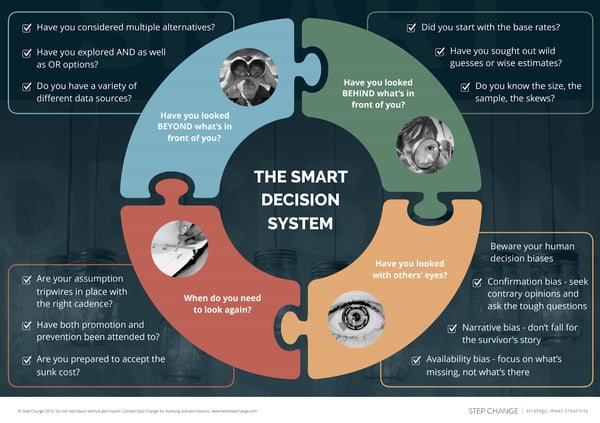As your business strives for growth, having the right strategy in place paves the road to success. But what does it take to deliver the best strategy? And how do you ensure you create a strong strategic plan that you can fully implement from start to finish?
Insight: There’s a big disconnect between strategy planning and its day-to-day implementation.
Data: 80% of leaders feel their company is good at crafting strategy but only 44% are truly effective at implementation (Robin Speculand). In a survey, 61% of respondents acknowledge that their firms often struggle to bridge the gap between strategy formulation and its day-to-day implementation (The Economist).
Key Action Point: Make use of these key insights and accompanying toolkits to improve how you implement your strategy and drive it to success.
In a previous post, I highlighted the 5 Powerful Business Strategy Tips to Fuel Your Growth which should help you get down to the basics of what a great strategy looks like and how it can help fuel your business growth.
To recap, I explained how purpose drives strategy and why strategy arises out of context in our changing world. I also shared the key tool, called Strategic Radar, we use with our clients for effective strategic planning that would unlock opportunities. Businesses who are looking to grow need to understand their purpose and use the right context to drive their strategy.
In today’s article, we’ll build on these foundations of strategy and focus on some toolkits and guides that we use to help our clients improve and create a great strategic plan.
8 Core Questions of Strategy
Strategy arises out of context, and in a rapidly evolving world, the context always changes. To succeed, you need to be aware of the changing context and how your business strategy can adapt. This is why businesses that win are often those most adaptive to change.
Thinking about a strategy that works according to your context and that which gives you the best results for your business can be overwhelming. How do you make sure your strategy covers the most critical variables?
When we’re working with clients who do not have a strategy in place yet, we take the time to sit with them and help them make sense of what is happening now, understand the right context, and build an informed strategy that drives results.
The best way to do this is by helping them dissect their needs, leaving no stone unturned by having them answer these core questions.
- What business are we in or should be in?
- Where do we compete?
- Who are our ideal target customers?
- What unique value do we bring?
- What’s the expression of that value (value proposition)?
- What resources and capabilities do we utilise?
- How do we sustain that unique value?
- How and where will we add value?
Your answers to these core questions will help you extract the key elements that you can use to create the right strategic plan.
Get Active Buy-in
Business leaders cannot build an effective strategy on their own. You need alignment across your organisation, and the only way to do that is through active buy-in. This means getting people involved and creating a culture that is aligned with your vision.
Culture needs strategy and vice versa. You need strategy to know where you’re going; you need culture to execute. You cannot do one without the other. Both of them need to work together.
Plan in Short Time Horizons
Phillip E. Tetlock wrote a research called “Expert Political Judgement: How good is it? How can we know?” in which he gathered 80,000+ predictions from 284 people considered experts in their field (people with the credentials to make believable predictions) relating to economic and political trends.
His research proved that we actually can’t trust experts for long-term or specific predictions.
In Step Change’s Smart Decision System, we talk about this in reference to the human tendency to trust “experts” for longer term or specific predictions rather than asking really simple questions like, “What’s the base rate (or most probable outcome) for this scenario?”
The research concludes that once you study thought leaders in a 12-month period, because of ego and hubris, they become less accurate than anyone tossing a coin.
The future is uncertain. Instead of creating a strategy based on long-term predictions from industry thought leaders, take the time to focus on the data that you have now and plan in short time horizons.
While it doesn’t mean you don’t plan for the long-term, you shouldn’t bet your strategy solely on what may or may not happen in the future. It should always be guided by the data that you do have now.

Who Does What by When?
Having clear objectives is crucial to framing success. To do this, we use the “[Verb] X to Y by [When]” diagram from Covey McChesney’s 4 Disciplines of Execution to help us set very clear objectives in the campaign so we stay on track.

The “[Verb] X to Y by [When]” diagram helps you in two ways:
- Having a clear view of what success looks like helps a client or a team member who may be contributing toward the resolution of our challenge to get aligned with the goal. Clearly identifying the objective of a challenge is an important process discipline that improves communication and collaboration throughout everyone in the team.
- Loopholes exist where human self-control is involved. If you are responsible for the objective outcome of a challenge, having a clear and simple formula helps you lay out your objective so you know exactly what you need to do to move towards a successful outcome.
Strategy on a Page
If you can’t say it in a simple way, do you really know and understand it? Can you outline your strategy on a page?
To help our clients tailor their strategy on a page and align their objectives, tactics, and strategy, we have them go through The Business Growth Canvass™, a toolkit that helps them assess their overarching purpose and their big hairy audacious goal (BHAG).
Here we help them zoom in on the core areas of focus: Strategy, Organisation, Systems, Staging, and Budgeting.
The Strategy: Know where to play and how to win.
- What problem needs solving? What are you trying to achieve?
- How are you solving the problem?
- Can you create an unfair advantage over competitors?
- How will you make money? What’s the model?
- What are the costs? Are the unit costs per sale less than what you sell for?
- How will you measure success?
The Organisation: Define and assign key strategic roles and functions across your entire organisation: the board, management, departments/teams, and partners.
Systems and Processes: Are all your systems in place? How do your IT, finance, CRM, and marketing tools and software fare in the equation? What’s the optimal level of investment? Do you build or just play and plug?
Staging and Budgeting: In what order and time frame will the necessary changes be made? What is the budget for each of the stages? What are the sources of funding?
Tying It Together
At the core of a great strategy is a clear and defined purpose — one that is embedded into the heart of your culture, where execution is done with the help of a team that is aligned on your objectives and tactics.
Whether or not you are still building your business strategy or already have a strategy in place that is just not working, these tips should help you re-assess what is missing so you can go back to the drawing board and think of another way to do it differently.

